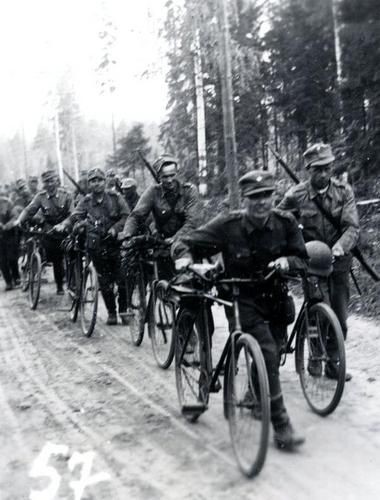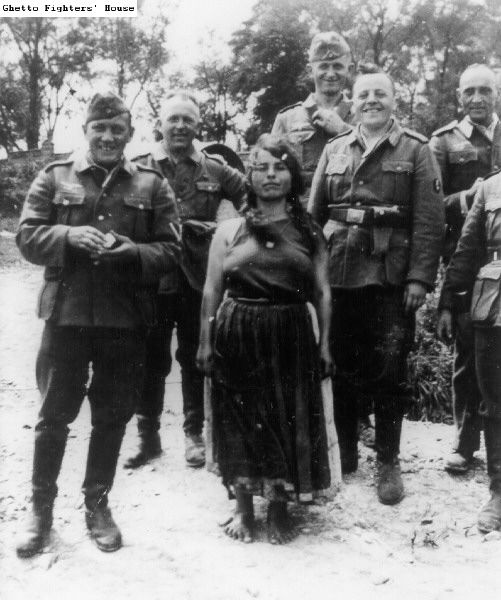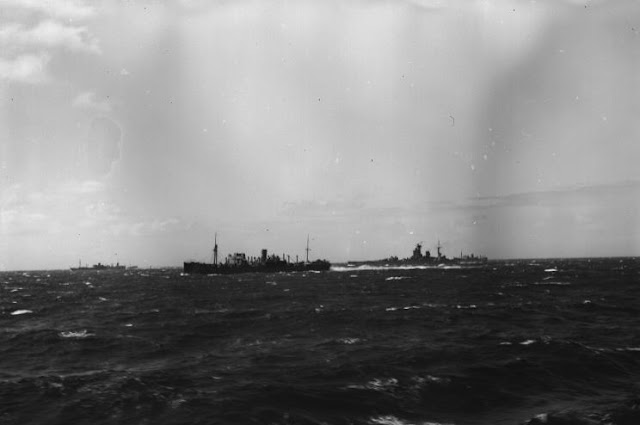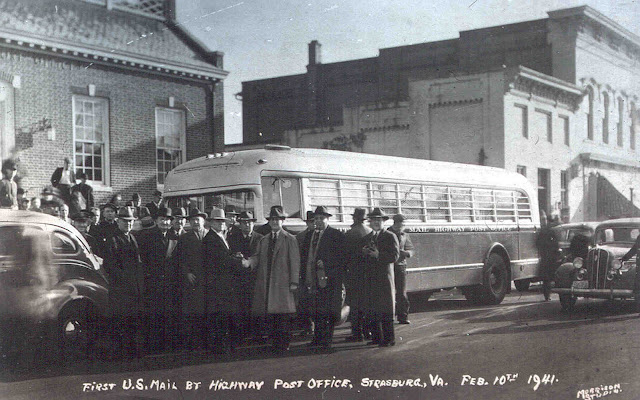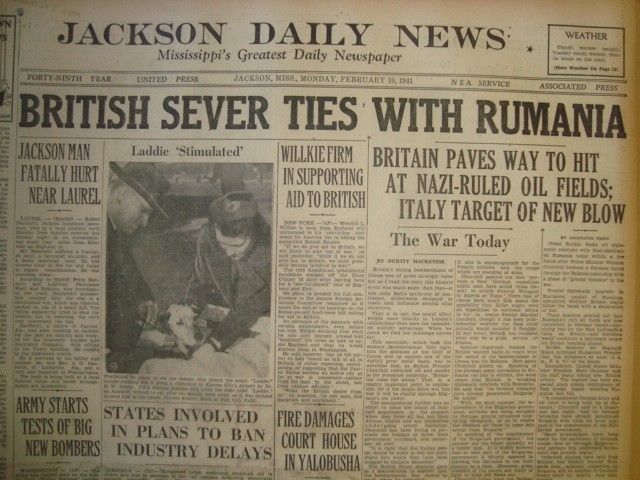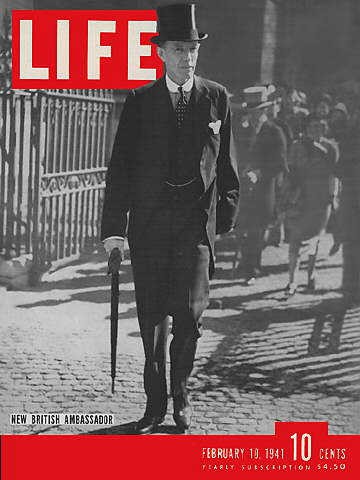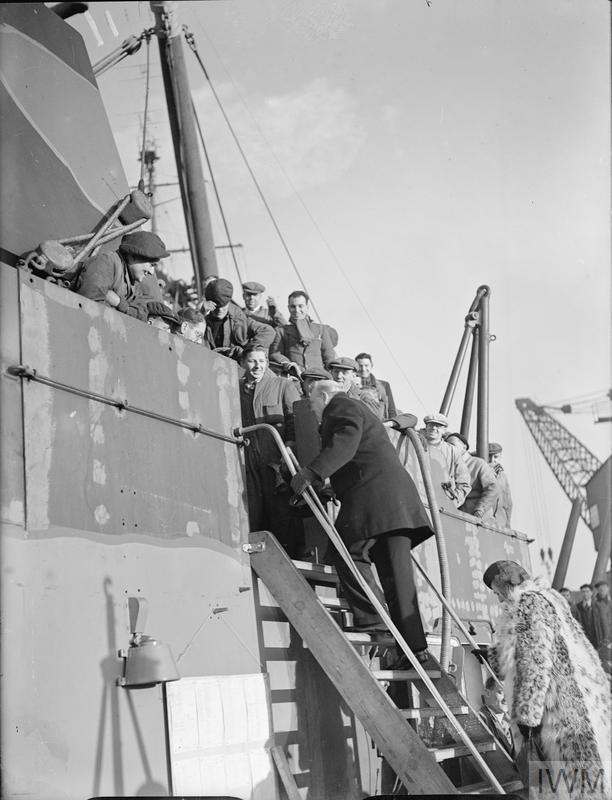Thursday 31 July 1941
 |
| A Finnish gunner inside the dorsal turret of a Bristol Blenheim bomber, July 31, 1941 (SA-Kuva). |
Eastern Front: The Germans on 31 July 1941 capture and interrogate an unnamed Soviet General Staff officer who gives tantalizing hints that the Soviets may be in the process of abandoning Leningrad. He says that the Stavka is shifting troops from the Leningrad perimeter to south of Lake Ilmen to defend the approaches to Moscow. The Germans also notice heavy rail traffic between Moscow and Leningrad. General Halder hopefully notes in the OKH war diary a single word: "evacuation?"
Halder also notes something more troubling in the war diary. He writes that Field Marshal Walther von Brauchitsch, the head of the German Army (ObdH), is simply transcribing Hitler's most recent Fuhrer directive directly into operational orders. Halder writes plaintively:
In the Far North sector, Finnish II Corps (Maj. Gen. Laatikainen) begins an offensive north of the Karelian Isthmus toward Lake Ladoga. One goal is to cut off the Soviet divisions that are northwest of the lake from their shortest withdrawal routes. The geographical target is the city of Viipuri (Vyborg), which Finland considers naturally its own possession and not Russian for historical reasons. The overall goal is the reconquest of the entire Karelian Isthmus. The defending Soviet 115th and 142nd Divisions have strong defensive positions and blunt the Finnish offensive.
In the Army Group North sector, German forces of the 16th Army secure the southwestern shore of Lake Ilmen. The Soviets counterattack from the direction of Toropets. General von Manstein's troops continue in the direction of Luga. The Soviets are putting up a strong defense at Kholm, which is preventing the Germans from transferring troops further south.
In the Army Group Center sector, there are only local Soviet counterattacks. The Soviets are building fortifications all along their positions and evidently they intend to make a stand where they are. The Soviets continue attacking the German "lightning rod" position at Yelnya from all directions. The Germans, meanwhile, continue reducing the Smolensk pocket while the trapped Soviet forces such as Group Kachalov attempt to break out.
In the Army Group South sector, the German Sixth Army continues to sidestep the large Soviet troop concentration at Kyiv to the south. Panzer Group 1 (General von Kleist) is operating west of Pervomaisk and attempting to envelop Soviet forces of the 12th Army. Soviet attacks against the 11th Army begin to increase in intensity during the day. Progress is slow for the Germans all across this sector.
European Air Operations: It is a quiet day on the air front in northwest Europe following several days of unsettled weather. The RAF sends four Blenheim bombers on a Roadstead sweep over St. Valery en Caux, and they return undamaged.
The Air Ministry reports that civilian air raid casualties during July 1941 were 900 killed and 908 injured.
Battle of the Baltic: U-140 (Hans-Jürgen Hellriegel) torpedoes and sinks 206-ton Soviet submarine M-94 (Lt Dyakov) at the entrance to the Gulf of Finland. Some sources place this on 21 or 22 July. There are three survivors. U-140 also attacks M-98 but misses.
Soviet minesweeper No. 46 sinks from unknown causes off Tallinn, Estonia.
The Luftwaffe (KG4) drops 38 mines at the mouth of the Triigi River, Saaremaa, Estonia.
Battle of the Atlantic: In Operation FB, the Royal Navy arrives at Advent Fjord, Spitsbergen. There are no Germans there, but about 700 Norwegians. Other ships arrive at Gronfjord, where there are 1800 Russians.
The Luftwaffe attacks 209-ton British freighter Onward about 20 miles east of Nolso, France.
Royal Navy destroyer HMS Vansittart intercepts 792-ton Vichy French freighter Oued Grou several hundred miles south of Dakar. The British take the ship to Freetown.
The Germans at Arcachon, France requisition 329-ton Italian trawler Sardella.
German 3172-ton blockade runner Natal arrives at Gironde, France.
Soviet destroyer Sokrushitelny meets British minelayer HMS Adventure near the Gorodetski lighthouse at the entrance to the White Sea in northern Russia. Adventure has been detached from Operation EF, the raid on Petsamo and Kirkenes.
Convoy ON-3 departs from Liverpool, Convoy SL-82 departs from Freetown bound for Liverpool. Ships intended for Convoy WS-10 (Winston Special) depart from Liverpool to join other ships arriving from other ports at sea.
Royal Navy corvettes HMS Monkshood (Lt. Commander James E. R. Wilford) and Pentstemon (Lt. Commander John Byron) are commissioned, escort carrier Pursuer is laid down.
Canadian corvette HMCS Battleford is commissioned in Montreal, Quebec (named after Battleford, Saskatchewan).
US destroyers USS Duncan, Lansdowne, and Pringle are laid down.
U-581 (Kapitänleutnant Werner Pfeifer) is commissioned, U-172 is launched, U-711 is laid down. The Kriegsmarine decommission U-B, which is the former Royal Navy submarine HMS Seal, at Kiel.
Allied shipping losses drop sharply in July 1941, from 389,316 tons in June to 109,276 tons in July. This undoubtedly is due to the diversion of German resources toward the Soviet Union. Allied losses are down sharply in every category, such as losses by U-boat down from 310,143 tons in June to 94,209 tons in July.
The silver lining for the Kriegsmarine is that they do not lose any U-boats during July after losing four in June. For its part, the Axis loses 12 ships of 47,055 tons in the Mediterranean. Admiral Doenitz has a fleet of 65 U-boats in operation during the month of July 1941.
Battle of the Mediterranean: As part of Operation Style, a British Force S convoy run from Gibraltar to Malta, the Royal Navy Force H detaches destroyers HMS Cossack and Maori to bombard Italian positions at Alghero, Sardinia. They also fire star shells to guide in RAF planes from aircraft carrier Ark Royal. This attack is intended to distract the Italians away from the convoy ships heading to Malta.
Royal Navy submarine HMS Regent (Lt. Knox) surfaces and uses its deck guns to sink 160-ton Italian sailing ship Igea about seven miles northeast of Benghazi (or a similar distance from Carcura, Libya).
The Luftwaffe bombs Tobruk before dawn and are met with heavy anti-aircraft fire.
The Italians attack St Angelo, Malta with three BR-20 bombers. They cause some damage to military facilities there and injure three people. Three other BR-20 bombers attack the Grand Harbour area.
US/Soviet Relations: President Roosevelt's personal emissary Harry Hopkins meets with Joseph Stalin in Moscow to discuss the terms of the United State's lend-lease aid to the USSR.
US/Japanese Relations: Japan lavishly apologizes for the bombing of USS Tutuila during a bombing raid of Chungking on the 30th. They call it "an accident, pure and simple."
Effective today, US exports of aviation motor fuels and lubricants and No. 1 heavy melting iron and steel scrap to Japan are put on the restricted list pursuant to the Export Control Act signed on 2 July 1940.
German/Swedish Relations: Having successfully transferred the 163rd Infantry Division in its entirety from Narvik, Norway to Finland on the railway line that runs across Swedish territory, the Germans ask for Swedish permission to transfer another division. The Swedes, who have been conflicted about the earlier decision, refuse.
German/Spanish Relations: Troops of the Spanish Blue Division are formally designated the Wehrmacht's 250th Infantry Division. They assemble prior to their departure to the front and swear allegiance to Adolf Hitler. They are destined for the Army Group North sector.
German Relations: Romanian leader Ion Antonescu acquiesces to Hitler's recent request to have Romanian troops conquer and occupy Ukrainian territory between the Bug and Dniester Rivers.
Ecuadorian/Peruvian Relations: After several days of discussion during which military operations continued, the two sides agree to a ceasefire in their border war. As a last military movement in the war, Peruvian troops arrive at Puerto Bolivar by ship and continue to operate against Ecuadorian troops in the Amazonian jungle.
German Military: General Ludwig Crüwell becomes commander of Afrika Corps while Lieutenant General Erwin Rommel is promoted to command of the new Panzerarmee Afrika. Panzer Army Africa is more the size of a corps than an army because it has only one infantry and two panzer divisions. While there are large Italian forces in North Africa, they remain under nominal Italian command. Crüwell is ill and does not take up his position until 15 September.
US Military: The Lockheed Ventura, a twin-engine medium bomber, makes its first flight. It is developed from the Lockheed Model 18 Lodestar transport. The British Purchasing Commission ordered 188 Venturas in February 1940 while the plane was still in the early stages of development.
US heavy cruiser USS Astoria arrives at Pearl Harbor, Hawaiian Islands.
Soviet Military: Soviet 43rd Army (Lieutenant General Ivan Zakharkin) becomes operational as part of General Georgy Zhukov's new Reserve Front pursuant to a Stavka order dated 30 July 1941. Its mission is to defend the Desna River south of Yelnya on the line of Kholmets and Bogdanovo.
Bulgarian Government: The Bulgarian government annexes its portion of the former Yugoslavia.
Holocaust: Reichsmarschall Hermann Goering sends RSHA (Reichssicherheitshaupamt) Obergruppenführer Reinhard Heydrich an order to make:
As it works out, the letter is meaningless to Heydrich (who is assassinated in 1942) but provides a "smoking gun" against Goering at the Nuremberg Trials (who futilely claims that the letter is mistranslated and only refers to a "desired solution," not a "final solution"). While things may have progressed as they did without this order, it provides legal cover for Heydrich to do whatever he wants to do - and Heydrich wants to do a lot where the Jews are concerned.
At Kishinev, Bessarabia (Moldova), the SS has killed about 10,000 Jews by the end of the month. At Zhytomyr, an additional 2500 are dead.
Einsatzcommando 3 reports executing 235 Jewish men, 16 Jewish women, and 5 non-Jews in the "Jäger Report."
Norwegian Homefront: Reich Commissar Josef Terboven issues a regulation that authorizes him to declare a civilian state of emergency. He does not do so at this time, however.
American Homefront: The New York Yankees lead the American League by 12.0 games over the second-place Cleveland Indians, while the St. Louis Cardinals leads the National League by 2.0 games over the Brooklyn Dodgers.
July 1941
July 1, 1941: US TV Broadcasting Starts
July 2, 1941: MAUD Report
July 3, 1941: Stalin Speaks
July 4, 1941: Pogroms in Eastern Europe
July 5, 1941: Germans on Schedule
July 6, 1941: Australians Attack Damour
July 7, 1941: US Marines in Iceland
July 8, 1941: Flying Fortresses In Action
July 9, 1941: British Take Damour
July 10, 1941: Sword and Scabbard Order
July 11, 1941: Cease-fire in Syria and Lebanon
July 12, 1941: Anglo/Russian Assistance Pact
July 13, 1941: Uprising in Montenegro
July 14, 1941: Katyusha Rocket Launchers in Action
July 15, 1941: Smolensk Falls
July 16, 1941: Stalin's Son Captured
July 17, 1941: Heydrich Orders Mass Executions
July 18, 1941: Twin Pimples Raid
July 19, 1941: V for Victory
July 20, 1941: The Man Who Wouldn't Shoot
July 21, 1941: Moscow in Flames
July 22, 1941: Soviet Generals Executed
July 23, 1941: Secret Plan JB 355
July 24, 1941: Operation Sunrise
July 25, 1941: US Naval Alert
July 26, 1941: Italian E-Boat Attack on Malta
July 27, 1941: MacArthur Returns
July 28, 1941: Auschwitz Exterminations
July 29, 1941: Rescue From Crete
July 30, 1941: Raid on Petsamo and Kirkenes
July 31, 1941: Final Solution Order
August 1941
August 1, 1941: More Executions on Crete
August 2, 1941: Uman Encirclement Closes
August 3, 1941: Bishop von Galen Denounces Euthanasia
August 4, 1941: Hitler at the Front
August 5, 1941: Soviets Surrender at Smolensk
August 6, 1941: U-Boats in the Arctic
August 7, 1941: Soviets Bomb Berlin
August 8, 1941: Uman Pocket Captured
August 9, 1941: Atlantic Conference at Placentia Bay
August 10, 1941: Soviet Bombers Mauled Over Berlin
August 11, 1941: Rita Hayworth in Life
August 12, 1941: Atlantic Charter Announced
August 13, 1941: The Soybean Car
August 14, 1941: The Anders Army Formed
August 15, 1941: Himmler at Minsk
August 16, 1941: Stalin's Order No. 270
August 17, 1941: Germans in Novgorod
August 18, 1941: Lili Marleen
August 19, 1941: Convoy OG-71 Destruction
August 20, 1941: Siege of Leningrad Begins
August 21, 1941: Stalin Enraged
August 22, 1941: Germans Take Cherkassy
August 23, 1941: Go to Kiev
August 24, 1941: Finns Surround Viipuri
August 25, 1941: Iran Invaded
August 26, 1941: The Bridge Over the Desna
August 27, 1941: Soviets Evacuate Tallinn
August 28, 1941: Evacuating Soviets Savaged
August 29, 1941: Finns take Viipuri
August 30, 1941: Operation Acid
August 31, 1941: Mannerheim Says No
2020
Halder also notes something more troubling in the war diary. He writes that Field Marshal Walther von Brauchitsch, the head of the German Army (ObdH), is simply transcribing Hitler's most recent Fuhrer directive directly into operational orders. Halder writes plaintively:
Unfortunately I cannot induce ObdH to inject into this order the slightest overtone expressive of a will of his own. Its wording is dictated by an anxiety to avoid anything that could be suspected as opposition to his superior.This continues a constant refrain in Halder's diary, that Hitler is tightening his grip on military operations and squeezing out all sense of direction aside from his own.
 |
| Finnish soldiers stand in lake Paanajärvi over the dead body of a Soviet soldier killed near Rukajärvi, Karelia, Finland (now Rugozero, Republic of Karelia, Russia). 31 July 1941 (SA-Kuva). |
In the Army Group North sector, German forces of the 16th Army secure the southwestern shore of Lake Ilmen. The Soviets counterattack from the direction of Toropets. General von Manstein's troops continue in the direction of Luga. The Soviets are putting up a strong defense at Kholm, which is preventing the Germans from transferring troops further south.
In the Army Group Center sector, there are only local Soviet counterattacks. The Soviets are building fortifications all along their positions and evidently they intend to make a stand where they are. The Soviets continue attacking the German "lightning rod" position at Yelnya from all directions. The Germans, meanwhile, continue reducing the Smolensk pocket while the trapped Soviet forces such as Group Kachalov attempt to break out.
In the Army Group South sector, the German Sixth Army continues to sidestep the large Soviet troop concentration at Kyiv to the south. Panzer Group 1 (General von Kleist) is operating west of Pervomaisk and attempting to envelop Soviet forces of the 12th Army. Soviet attacks against the 11th Army begin to increase in intensity during the day. Progress is slow for the Germans all across this sector.
 |
| Captain Eric S. Lock of the RAF in the cockpit of his Spitfire Mk.V with his dog, 31 July 1941. |
The Air Ministry reports that civilian air raid casualties during July 1941 were 900 killed and 908 injured.
Battle of the Baltic: U-140 (Hans-Jürgen Hellriegel) torpedoes and sinks 206-ton Soviet submarine M-94 (Lt Dyakov) at the entrance to the Gulf of Finland. Some sources place this on 21 or 22 July. There are three survivors. U-140 also attacks M-98 but misses.
Soviet minesweeper No. 46 sinks from unknown causes off Tallinn, Estonia.
The Luftwaffe (KG4) drops 38 mines at the mouth of the Triigi River, Saaremaa, Estonia.
 |
| HMCS Battleford, commissioned on 31 July 1941, off the East Coast of the United States, 5 October 1943. |
The Luftwaffe attacks 209-ton British freighter Onward about 20 miles east of Nolso, France.
Royal Navy destroyer HMS Vansittart intercepts 792-ton Vichy French freighter Oued Grou several hundred miles south of Dakar. The British take the ship to Freetown.
The Germans at Arcachon, France requisition 329-ton Italian trawler Sardella.
German 3172-ton blockade runner Natal arrives at Gironde, France.
Soviet destroyer Sokrushitelny meets British minelayer HMS Adventure near the Gorodetski lighthouse at the entrance to the White Sea in northern Russia. Adventure has been detached from Operation EF, the raid on Petsamo and Kirkenes.
Convoy ON-3 departs from Liverpool, Convoy SL-82 departs from Freetown bound for Liverpool. Ships intended for Convoy WS-10 (Winston Special) depart from Liverpool to join other ships arriving from other ports at sea.
Royal Navy corvettes HMS Monkshood (Lt. Commander James E. R. Wilford) and Pentstemon (Lt. Commander John Byron) are commissioned, escort carrier Pursuer is laid down.
Canadian corvette HMCS Battleford is commissioned in Montreal, Quebec (named after Battleford, Saskatchewan).
US destroyers USS Duncan, Lansdowne, and Pringle are laid down.
U-581 (Kapitänleutnant Werner Pfeifer) is commissioned, U-172 is launched, U-711 is laid down. The Kriegsmarine decommission U-B, which is the former Royal Navy submarine HMS Seal, at Kiel.
Allied shipping losses drop sharply in July 1941, from 389,316 tons in June to 109,276 tons in July. This undoubtedly is due to the diversion of German resources toward the Soviet Union. Allied losses are down sharply in every category, such as losses by U-boat down from 310,143 tons in June to 94,209 tons in July.
The silver lining for the Kriegsmarine is that they do not lose any U-boats during July after losing four in June. For its part, the Axis loses 12 ships of 47,055 tons in the Mediterranean. Admiral Doenitz has a fleet of 65 U-boats in operation during the month of July 1941.
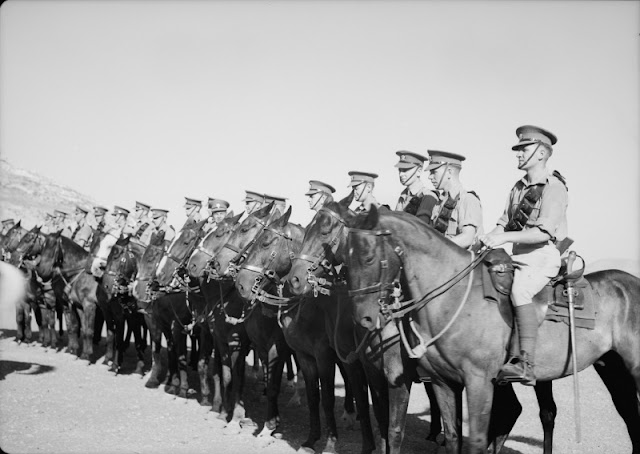 |
| Scots Dragoons of the "Royal Scotts Greys" Regiment fall in on horseback near Nablus, Palestine on July 31, 1941. The photo was taken after the regiment returned from fighting in Syria and Lebanon. |
Royal Navy submarine HMS Regent (Lt. Knox) surfaces and uses its deck guns to sink 160-ton Italian sailing ship Igea about seven miles northeast of Benghazi (or a similar distance from Carcura, Libya).
The Luftwaffe bombs Tobruk before dawn and are met with heavy anti-aircraft fire.
The Italians attack St Angelo, Malta with three BR-20 bombers. They cause some damage to military facilities there and injure three people. Three other BR-20 bombers attack the Grand Harbour area.
 |
| Braunschweig, Ruhfäutchenplatz. On the left is the New Town Hall, at the center of the picture is tram line 3, at the right is Dankwarderode Castle (Proietti, Ugo, Federal Archive, Bild 212-267). |
US/Japanese Relations: Japan lavishly apologizes for the bombing of USS Tutuila during a bombing raid of Chungking on the 30th. They call it "an accident, pure and simple."
Effective today, US exports of aviation motor fuels and lubricants and No. 1 heavy melting iron and steel scrap to Japan are put on the restricted list pursuant to the Export Control Act signed on 2 July 1940.
German/Swedish Relations: Having successfully transferred the 163rd Infantry Division in its entirety from Narvik, Norway to Finland on the railway line that runs across Swedish territory, the Germans ask for Swedish permission to transfer another division. The Swedes, who have been conflicted about the earlier decision, refuse.
German/Spanish Relations: Troops of the Spanish Blue Division are formally designated the Wehrmacht's 250th Infantry Division. They assemble prior to their departure to the front and swear allegiance to Adolf Hitler. They are destined for the Army Group North sector.
German Relations: Romanian leader Ion Antonescu acquiesces to Hitler's recent request to have Romanian troops conquer and occupy Ukrainian territory between the Bug and Dniester Rivers.
 |
| "Lord Derby is seen talking with Mrs. T A Hussey." The opening of the new extension of the Flotilla Club, 31 July 1941. © IWM (A 4698). |
German Military: General Ludwig Crüwell becomes commander of Afrika Corps while Lieutenant General Erwin Rommel is promoted to command of the new Panzerarmee Afrika. Panzer Army Africa is more the size of a corps than an army because it has only one infantry and two panzer divisions. While there are large Italian forces in North Africa, they remain under nominal Italian command. Crüwell is ill and does not take up his position until 15 September.
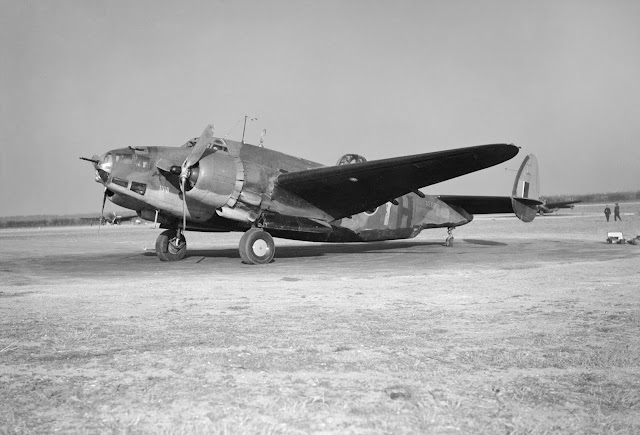 |
| A Lockheed Ventura of RAF No. 21 Squadron ca. 1941. |
US heavy cruiser USS Astoria arrives at Pearl Harbor, Hawaiian Islands.
Soviet Military: Soviet 43rd Army (Lieutenant General Ivan Zakharkin) becomes operational as part of General Georgy Zhukov's new Reserve Front pursuant to a Stavka order dated 30 July 1941. Its mission is to defend the Desna River south of Yelnya on the line of Kholmets and Bogdanovo.
 |
| A translation of the 31 July 1941 letter from Reichsmarschall Hermann Goering to Reinhard Heydrich regarding the "Final Solution" (Truman Library). |
Holocaust: Reichsmarschall Hermann Goering sends RSHA (Reichssicherheitshaupamt) Obergruppenführer Reinhard Heydrich an order to make:
all the necessary preparations with regard to organizational, practical and financial aspects for an overall solution (Gesamtlosung) of the "Jewish question" in the German sphere of influence in Europe.Heydrich already has verbally instructed the SS to exterminate entire groups of people, including Jews, and even put it in writing. However, some later assume that Heydrich specifically asks Goering for this after-the-fact authorization letter. In colloquial terms, it is a "cover your butt" letter for Heydrich's benefit.
As it works out, the letter is meaningless to Heydrich (who is assassinated in 1942) but provides a "smoking gun" against Goering at the Nuremberg Trials (who futilely claims that the letter is mistranslated and only refers to a "desired solution," not a "final solution"). While things may have progressed as they did without this order, it provides legal cover for Heydrich to do whatever he wants to do - and Heydrich wants to do a lot where the Jews are concerned.
At Kishinev, Bessarabia (Moldova), the SS has killed about 10,000 Jews by the end of the month. At Zhytomyr, an additional 2500 are dead.
Einsatzcommando 3 reports executing 235 Jewish men, 16 Jewish women, and 5 non-Jews in the "Jäger Report."
Norwegian Homefront: Reich Commissar Josef Terboven issues a regulation that authorizes him to declare a civilian state of emergency. He does not do so at this time, however.
American Homefront: The New York Yankees lead the American League by 12.0 games over the second-place Cleveland Indians, while the St. Louis Cardinals leads the National League by 2.0 games over the Brooklyn Dodgers.
 |
| The original and infamous "final solution" letter from Hermann Goering to Reinhard Heydrich, 31 July 1941 |
July 1941
July 1, 1941: US TV Broadcasting Starts
July 2, 1941: MAUD Report
July 3, 1941: Stalin Speaks
July 4, 1941: Pogroms in Eastern Europe
July 5, 1941: Germans on Schedule
July 6, 1941: Australians Attack Damour
July 7, 1941: US Marines in Iceland
July 8, 1941: Flying Fortresses In Action
July 9, 1941: British Take Damour
July 10, 1941: Sword and Scabbard Order
July 11, 1941: Cease-fire in Syria and Lebanon
July 12, 1941: Anglo/Russian Assistance Pact
July 13, 1941: Uprising in Montenegro
July 14, 1941: Katyusha Rocket Launchers in Action
July 15, 1941: Smolensk Falls
July 16, 1941: Stalin's Son Captured
July 17, 1941: Heydrich Orders Mass Executions
July 18, 1941: Twin Pimples Raid
July 19, 1941: V for Victory
July 20, 1941: The Man Who Wouldn't Shoot
July 21, 1941: Moscow in Flames
July 22, 1941: Soviet Generals Executed
July 23, 1941: Secret Plan JB 355
July 24, 1941: Operation Sunrise
July 25, 1941: US Naval Alert
July 26, 1941: Italian E-Boat Attack on Malta
July 27, 1941: MacArthur Returns
July 28, 1941: Auschwitz Exterminations
July 29, 1941: Rescue From Crete
July 30, 1941: Raid on Petsamo and Kirkenes
July 31, 1941: Final Solution Order
August 1941
August 1, 1941: More Executions on Crete
August 2, 1941: Uman Encirclement Closes
August 3, 1941: Bishop von Galen Denounces Euthanasia
August 4, 1941: Hitler at the Front
August 5, 1941: Soviets Surrender at Smolensk
August 6, 1941: U-Boats in the Arctic
August 7, 1941: Soviets Bomb Berlin
August 8, 1941: Uman Pocket Captured
August 9, 1941: Atlantic Conference at Placentia Bay
August 10, 1941: Soviet Bombers Mauled Over Berlin
August 11, 1941: Rita Hayworth in Life
August 12, 1941: Atlantic Charter Announced
August 13, 1941: The Soybean Car
August 14, 1941: The Anders Army Formed
August 15, 1941: Himmler at Minsk
August 16, 1941: Stalin's Order No. 270
August 17, 1941: Germans in Novgorod
August 18, 1941: Lili Marleen
August 19, 1941: Convoy OG-71 Destruction
August 20, 1941: Siege of Leningrad Begins
August 21, 1941: Stalin Enraged
August 22, 1941: Germans Take Cherkassy
August 23, 1941: Go to Kiev
August 24, 1941: Finns Surround Viipuri
August 25, 1941: Iran Invaded
August 26, 1941: The Bridge Over the Desna
August 27, 1941: Soviets Evacuate Tallinn
August 28, 1941: Evacuating Soviets Savaged
August 29, 1941: Finns take Viipuri
August 30, 1941: Operation Acid
August 31, 1941: Mannerheim Says No
2020

